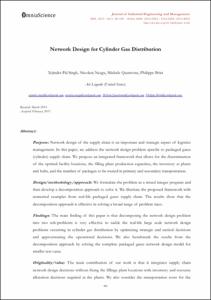Mostra el registre d'ítem simple
Network design for cylinder gas distribution
| dc.contributor.author | Singh, Tejinder Pal |
| dc.contributor.author | Neagu, Nicoleta |
| dc.contributor.author | Quattrone, Michele |
| dc.contributor.author | Briet, Philippe |
| dc.date.accessioned | 2015-04-20T14:43:37Z |
| dc.date.available | 2015-04-20T14:43:37Z |
| dc.date.issued | 2015-04 |
| dc.identifier.citation | Singh, Tejinder Pal [et al.]. Network design for cylinder gas distribution. "Journal of Industrial Engineering and Management", Abril 2015, vol. 8, núm. 1, p. 85-109. |
| dc.identifier.issn | 2013-0953 |
| dc.identifier.uri | http://hdl.handle.net/2099/16345 |
| dc.description.abstract | Purpose: Network design of the supply chain is an important and strategic aspect of logistics management. In this paper, we address the network design problem specific to packaged gases (cylinder) supply chain. We propose an integrated framework that allows for the determination of the optimal facility locations, the filling plant production capacities, the inventory at plants and hubs, and the number of packages to be routed in primary and secondary transportation. Design/methodology/approach: We formulate the problem as a mixed integer program and then develop a decomposition approach to solve it. We illustrate the proposed framework with numerical examples from real-life packaged gases supply chain. The results show that the decomposition approach is effective in solving a broad range of problem sizes. Findings: The main finding of this paper is that decomposing the network design problem into two sub-problems is very effective to tackle the real-life large scale network design problems occurring in cylinder gas distribution by optimizing strategic and tactical decisions and approximating the operational decisions. We also benchmark the results from the decomposition approach by solving the complete packaged gases network design model for smaller test cases. Originality/value: The main contribution of our work is that it integrates supply chain network design decisions without fixing the fillings plant locations with inventory and resource allocation decisions required at the plants. We also consider the transportation costs for the entire supply chain including the transhipment costs among different facilities by deciding the replenishment frequency. |
| dc.format.extent | 25 p. |
| dc.language.iso | eng |
| dc.publisher | OmniaScience |
| dc.rights | Attribution-NonCommercial 3.0 Spain |
| dc.rights.uri | http://creativecommons.org/licenses/by-nc/3.0/es/ |
| dc.subject | Àrees temàtiques de la UPC::Economia i organització d'empreses::Direcció d’operacions::Modelització de transports i logística |
| dc.subject.lcsh | Business logistics |
| dc.subject.lcsh | Gas distribution |
| dc.subject.lcsh | Inventory management |
| dc.subject.other | Network design |
| dc.subject.other | Optimization |
| dc.subject.other | Location-routing |
| dc.subject.other | Packaged gases |
| dc.subject.other | Inventory management |
| dc.subject.other | Decomposition approach |
| dc.subject.other | Heuristics |
| dc.subject.other | Mixed integer linear programming |
| dc.title | Network design for cylinder gas distribution |
| dc.type | Article |
| dc.subject.lemac | Gas -- Distribució |
| dc.subject.lemac | Logística (Indústria) -- Models matemàtics |
| dc.subject.lemac | Gestió d'estocs |
| dc.identifier.dl | B-28744-2008 |
| dc.description.peerreviewed | Peer Reviewed |
| dc.rights.access | Open Access |
| local.citation.author | Singh, Tejinder Pal; Neagu, Nicoleta; Quattrone, Michele; Briet, Philippe |
| local.citation.publicationName | Journal of Industrial Engineering and Management |
| local.citation.volume | 8 |
| local.citation.number | 1 |
| local.citation.startingPage | 85 |
| local.citation.endingPage | 109 |
Fitxers d'aquest items
Aquest ítem apareix a les col·leccions següents
-
2015, vol. 8, núm. 1 [17]


